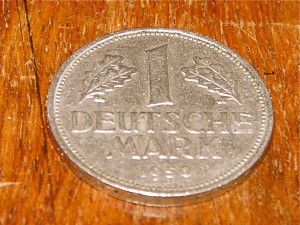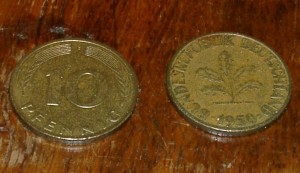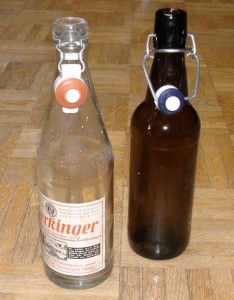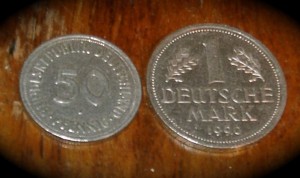 A few days ago, I found an article (which is certainly worth reading) on “optimism and what the youngsters knows” in the SZ. Here is the “teaser” of the article:
A few days ago, I found an article (which is certainly worth reading) on “optimism and what the youngsters knows” in the SZ. Here is the “teaser” of the article:
Social market economy? I do not know what that means. Inflation? I have never heard of it! A survey reveals that our youngsters know frighteningly little about economy – regardless of the crisis. (Translation of original SZ sentence)
🙂 As a service for our young readers, I would like to make a contribution towards alleviating the German educational misery by describing what inflation means in four examples.
Example number 1: Ten Deutsche Pfennige in my childhood
 During the 1950ies, if someone gave me a “Zehnerl” (that is how the 10-cent coin was called), this was really some money. At the bakery, I could, for instance, buy 2 rolls or a pretzel and a fruit stick.
During the 1950ies, if someone gave me a “Zehnerl” (that is how the 10-cent coin was called), this was really some money. At the bakery, I could, for instance, buy 2 rolls or a pretzel and a fruit stick.
In those days, bakeries were small places that were easy to understand. They were systems that emitted a wonderful smell and when you entered flour at the rear, what you got in the front was bread and rolls and many other tasty goodies.
In Munich, if you buy 2 rolls at a real bakery today, you pay around a EURO (mathematically spoken, that is the equivalent of 20 “Zehnerln”).
Example number 2: Bottle deposit and association football
 Once upon a time, the BCA (Ballspielclub Augsburg) played against Schwaben Augsburg in the Rosenaustadium. That was also in the 1950ies, and the beer in the stadium was still sold in heavy glass bottles with metal brackets and a lid made of porcelain.
Once upon a time, the BCA (Ballspielclub Augsburg) played against Schwaben Augsburg in the Rosenaustadium. That was also in the 1950ies, and the beer in the stadium was still sold in heavy glass bottles with metal brackets and a lid made of porcelain.
That worked, because in those days nobody would have even dreamed of throwing beer bottles onto the playfield, no matter how much the referee annoyed us – which he often did!
After the match, people often made quite a stampede trying to get onto the special busses provided by the Augsburger Stadtwerke. And many people left the empty beer bottles on the seats, because they were in a hurry.
If great teams had played, this was really a stroke of luck for us. We got busy collecting beer bottles, carried them one on each finger (which was possible because of the metal brackets) and within 5 minutes I had earned 2 DM.
 Both teams played in the highest German league, the “Oberliga”. Admittance for students was 50 Pfennige, which was really expensive in those days. Well, after the expenses, that left me with 1.50 Deutsche Mark surplus, which was just enough for a roast pork at Riegele’s.
Both teams played in the highest German league, the “Oberliga”. Admittance for students was 50 Pfennige, which was really expensive in those days. Well, after the expenses, that left me with 1.50 Deutsche Mark surplus, which was just enough for a roast pork at Riegele’s.
When I was older, I was also permitted to sell beer. The price was one DM, 20 Pfennige of which was bottle deposit and 10 Pfennige my provision. Now I wish I knew what 0.4 litres of beer cost in the Allianz Arena. However, not long ago, I paid 4.50 Euros (9 Deutsche Mark without tip) for a wheat beer.
Example number 3: My father-in-law’s house
I never met my father-in-law, because he died before I met Barbara. However, he must have been a very wise (well, he read Karl Jaspers) and clever man (he was a mathematician). And, being a public officer, he was also very cautious and always wanted to know that his family is well provided for at all times.
Also in the 1950ies, he bought a semi-detached house in Stadtbergen on a reasonably big property for around 25,000 DM. He had about 20% of the money in cash, the remaining 20,000 DM were financed through a long-term loan.
For repaying the loan, he opened a capital insurance account that was to yield almost twice the sum of the loan by the time it was paid out, including the expected profit sharing. He expected to have real money left over after all the loan was paid back.
When, in the early 1980ies, both the loan and the insurance contracts were fulfilled, what remained after repaying the debt was around 12,000 Mark. Naturally, in the 1980ies, that was no longer such a huge amount of money (nowhere near half a semi-detached house). It was just enough for a middle-class car, and today, that car is also no longer among the living.
Example number 4: My first terraced house
In 1979, Barbara and I decided that we wanted to finish with our “concubinage” days and start a family. For me, it was important that the wild horde I expected to father would be able to really let off steam. As I saw it, this was only possible if you owned some property with a reduced neighbourhood structure. That is why we bought a small, second-hand terraced house in the Adam-Berg-Straße in Munich Altperlach/Ramersdorf, directly behind the Garden Centre Seebauer.
At the time, we paid 285,000 DM, and a few years later, we sold it for almost 400,000 DM. Perhaps nowadays, with a little luck, you could buy it for 400,000 Euros? Although I am not too confident, because, even though it is small, it is convenient for traffic and there is a real nice garden both in front and behind the house.
And, mind you, we had almost no inflation during the last 30 years.
Have you now understood the meaning of the word inflation?
RMD
P.S. Unfortunately, I cannot take a picture of the semi-detached house in Stadtbergen. It was sold (for quite a few Euros) and then destroyed. And I do not dare take a picture of my former abode in the Adam-Berg-Straße. Just think of Google street maps.
🙂 The Deutsche Mark on the first picture is as old as yours truly.
(Translated by EG)

